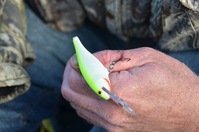
They say you shouldn’t drink the water when traveling south of the border, because you might be afflicted with an unflattering ailment known as Montezuma’s Revenge. If you venture north of the border, the water’s fine. But when in Canada, beware of the fish. I learned this the hard way last week, when Outdoor News editor Rob Drieslein joined me on a quest for king salmon in the Nipigon River on Lake Superior’s North Shore. Ray Rivard, our host at the nearby Quebec Lodge, offered to spend a morning on the river with us. We were trolling with crankbaits when I hooked and landed a one of the river’s famed coaster brook trout. Clearly unhappy to be in the boat, the brookie struggled in the rubber-mesh landing net, which amplified each frantic flop as if it was bouncing on a trampoline.
Cautiously, I tried to pick up the fish without getting caught on the lure’s second set of hooks. I failed. Suddenly, I was hooked by the thumb to the trampoline trout.
“Not good,” I said. “Really not good.”
Moving quickly, Ray grabbed and held the fish while we tried to figure out what to do next. Using the multitool I carry on my belt, we cut the hook holding the fish and released it. This left me with a deeply imbedded crankbait in my thumb. Fortunately, the emergency room at the Nipigon Hospital was just a 20-minute drive away. Ray and Rob returned me to the boat landing and I headed to town.
When I arrived at the emergency room, the nurse directed me first to registration. The woman there recoiled and back-pedaled from the counter when she saw my thumb. “I don’t want to see that,” she exclaimed. As she registered me, I learned she likes to fish and has a phobia about hook impalements. From my impaled perspective, her phobia was understandable. With tongue in cheek, I said her initial reaction was almost worth getting hooked.
Finally, I went back to the ER and met Dr. Myhill-Jones, who was no stranger to fish hook injuries.“I live in coastal B.C.,” he explained, “so I’ve removed a lot of fish hooks.”
His favorite way to pull them out is what he called the string method. This entails putting a loop of line around the bend of the impaled hook, pushing down on the hook eye to improve the angle and then using the line to pull the hook out with a quick motion. I’ve used this method previously and it works. This time, however, the hook seemed too deeply embedded. At any rate, I wanted to ensure my thumb was numb before any removal process began.
Examining the wound, the doctor agreed the hook was especially deep and decided to use an alternate method, which involves pushing the point and barb back through the skin, cutting off the barb and then backing out the hook. As long as numbness was involved, this was fine by me. So we started with a shot of a topical anesthetic. Then the doctor asked the nurse for a pliers and wire cutter. She looked in the cabinet, but was only able to find an odd-looking cutting tool. The doctor tried to cut the split ring that attached the hook to the lure, but was unsuccessful after several attempts.
“Do you want to try my cutter?” I asked, pulling out the trusty multi-tool. It worked on the first try. I asked if I’d get a discount for bringing my own utensils. The doctor smiled. Then, using the pliers on the multi-tool, he pushed the hook point back through the skin. The final step was to cut off the barb—again with the multitool—and slip the hook out.
Around this time a young doctor came into the room. Dr. Myhill-Jones asked him how he usually removed hooks. Surprisingly, the doctor responded that they didn’t often deal with hook impalements. He hadn’t tried the string method. Suddenly, my impalement became a teaching opportunity. Dr. Myhill-Jones asked if he could use my thumb for demonstration purposes. When I agreed, the other doctor scurried off to find the resident physician, another fish hook neophyte. Since my camera was in my pocket, I decided to photograph the demonstration.
The young doctor and the resident physician soon returned. Dr. Myhill-Jones pulled out a roll of gauze. He glanced at my trusty multitool.
“Does your tool have a scissors?” he asked. It does, so he used it to cut a length of gauze. He tied the ends to create a loop about six or eight inches in diameter. Then he slipped it on his wrist, so the loop lay in the palm of his hand. This way, he could make a smooth pull to remove the hook. He showed us how to position the loop in the hook bend and to press down on the eye. Then he showed us how to pull the hook out. Of course, the barb was already cut off, so the hook easily slipped out.
All that now remained of my ER experience was the billing. If I was a Canadian resident, all I would have needed to do was show my health card and the entire service would be covered. As a nonresident, I was presented with a $405 bill, due immediately. Out came my credit card. The charge was a standard emergency room fee. For me, it covered the procedure, a topical anesthetic and a tetanus shot. I can turn in the bill as a claim to my U.S. health insurance.
Leaving the hospital, I decided a donut was in order and stopped for a snack at the Nipigon Tim Horton’s. Then it was back to the river. The boys motored over to pick me up. While I was gone, Rob managed to land his first king salmon. We fished for a couple of hours without catching any more salmon, a 10-pounder. However, I did land a limit of hook-in-thumb jokes. And somewhere beneath the boat, a Nipigon River brook trout was savoring sweet revenge.




